10 Best PR Tools That You Should Know About
- Home
- Intelligent Insights Blog
- 10 Best PR Tools That You Should Know About
Running a PR campaign can be challenging due to various factors.
It takes consistent effort to manage and shape the narrative around your brand or organization.
Plus, measuring the success of a PR campaign can be challenging, as its impact is often intangible or difficult to quantify.
The good news is that many PR tools can do the work for you.
These tools provide the necessary infrastructure, efficiency, and data insights to manage your PR. They can also help you build relationships with stakeholders and navigate crises.
These tools are essential for maximizing the impact of your PR campaigns and achieving your communication goals.
There are tons of software, platforms, and resources that can help you manage and enhance your PR efforts. PR tools are designed to:
- Streamline Tasks
- Monitor Media Coverage
- Analyze Data
- Facilitate Effective Communication with Target Audiences
- Distribute Press Releases
- Manage Social Media
- Track Influencers and Trending Content
- Create Reports
In this article, you’ll find a list of 10 of the best PR tools that can help supercharge your PR efforts.
Ready to get started with an AI PR tool and earn more media coverage?
Book a free Preston demo with one of our PR experts and we’ll show you how our AI PR tool can help you achieve your PR goals and earn better media coverage faster.
1. Intelligent Relations

Intelligent Relations is the company behind Preston, a powerful AI PR tool that boosts your PR efforts with cutting-edge AI features and PR media databases. Plus, Preston comes with the PR expertise you need to create strategic communication and media relations even if you’re new at PR.
Preston helps marketers, businesses, and individuals effectively manage their public image, earn media coverage, and build strong relationships with key stakeholders.
Pros of Intelligent Relations:
- Enhanced Earned Media Coverage: Land podcast interviews, submit thought leadership, send press releases, and earn media coverage – all from the Preston platform.
- Dedicated PR Pro: When you sign up for Preston, you get 5 hours per month with a PR professional to help you strategize and execute your PR campaigns.
- Customized Solutions: If you feel like you need more help, Intelligent Relations offers tailored solutions to fit your specific PR needs. You’ll receive support from a team of experts that understands that every brand requires a personalized PR strategy.
- Strategic Approach: Your Pro will take a data-driven and strategic approach to PR with the help of sophisticated AI algorithms. Based on your company input, they analyze market trends, target audience behavior, and media landscapes to create relevant, effective PR campaigns.
- Access to Databases: With Preston, you get access to 570K+ (and growing) media contacts, including journalists, publications, podcasts, influencers, editors, and more. Our AI matches you with contacts that are the most relevant and likely to respond to your pitch and story ideas.
- AI Assisted Workflows and Pitch Writing: AI workflows and pitch writing help you save time and resources by automating PR tasks. For pitches, Preston uses your company data and input to generate relevant pitches matched to relevant publications and journalists. You can ask your PR Pro to help you edit, tailor, and personalize these pitches before launching them as campaigns.
Cons of Intelligent Relations:
- Resource Dependency: Working with Intelligent Relations requires active involvement from the client’s side. It may be challenging if you have limited internal resources to fulfill these requirements.
- Results May Vary: While Intelligent Relations provides strategic services, success is not always guaranteed. The effectiveness of PR campaigns can be influenced by external factors, market conditions, and audience receptiveness.
You’ve got your PR tools selected. But what are you supposed to track and analyze? Check out our article on PR metrics: 10 Key PR Metrics You Must Measure to Gauge Success
2. BuzzSumo

Are you looking for a platform that helps you discover engaging and popular content? Do you want to monitor brand mentions and analyze content performance?
Look no further than BuzzSumo, one of the leading PR tools.
BuzzSumo allows you to analyze and track content performance across various social media platforms. Plus, it helps you discover engaging niche content.
Pros of BuzzSumo:
- Targeted Outreach: BuzzSumo’s Media Database is one of the PR tools on the list that can help you identify the right journalists and influencers. This ensures that you’re connecting with the most relevant people who can amplify your message.
- Content Discovery: You can discover trending content and stay up-to-date with the latest news in your industry. This helps you identify potential media opportunities and tailor your pitches accordingly.
- Competitor Intelligence: This feature helps you benchmark your PR performance against your competitors. This allows you to gain valuable insights to inform your own PR strategy.
- Crisis Alerting: BuzzSumo’s Crisis Alerting feature can help you monitor online conversations. This allows you to quickly identify potential crises and take proactive measures.
- Content Strategy: Use in-depth research and insights to develop compelling content strategies. You can optimize your PR efforts to create engaging content that resonates with your target audience.
- Influencer Marketing: This feature helps you identify influencers with authority in your industry. This helps you build meaningful relationships and secure impactful coverage.
Cons of Buzzsumo:
- Price: Buzzsumo is one of the premium PR tools listed and has various pricing tiers. The cost may be a deterrent for small businesses or individuals on a tight budget.
- Limited Social Media Platforms: Buzzsumo covers popular platforms like Facebook, Twitter, and LinkedIn. But it doesn’t include all social media channels. This could limit your ability to track content performance.
- Competitive Market: Buzzsumo operates in a competitive market, with other content research and social media monitoring tools. Each platform has its own unique features. It’s important to compare and evaluate which tool aligns best with your specific needs.
3. HootSuite
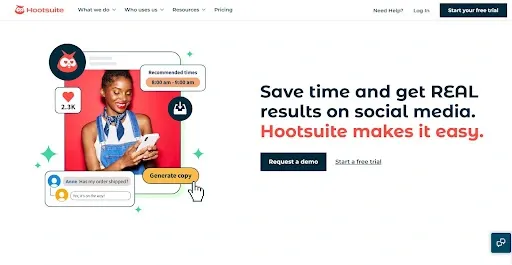
Social media platforms offer the ability to disseminate information, news, and updates in real time. But with so many platforms out there, not many PR tools manage all of them at once.
That’s where HootSuite comes in.
With HootSuite, users can schedule posts across multiple social networks and get a preview of how their posts will appear. The platform also provides customizable streams to monitor trends and stay notified about specific topics or competitors.
Pros of HootSuite:
- Centralized Dashboard: For brands with lots of social media channels, this is one of the best PR tools for monitoring and managing multiple social media accounts in one place. This allows for efficient scheduling and publishing of posts across various platforms, saving time and effort.
- Follower Engagement: The ability to engage with followers and respond to messages and comments.
- Analytics Tools: Robust analytics and reporting capabilities. This enables you to track and measure the performance of your social media efforts.
- Social Listening Tools: These tools allow you to monitor brand mentions, industry trends, and competitor activity. They provide valuable insights to inform marketing strategies.
- Integration with Other Platforms: HootSuite integrates with other platforms and tools. This allows for seamless workflows and increased productivity.
Cons of HootSuite:
- Complexity for Beginners: HootSuite’s extensive features and functionalities can be overwhelming for beginners. This is one of the PR tools with the steepest learning curves.
- Limited Platform-specific Features: HootSuite supports multiple social media platforms. But some platform-specific features may be limited or not available.
- Cost: HootSuite offers various pricing plans, including a free version with limited features. But to access more advanced features and capabilities, you may need to upgrade to a paid plan.
- User Interface: Some users find HootSuite’s user interface to be less intuitive or visually appealing compared to other social media management platforms.
Want to know how to merge PR and social media for enhanced results for all your campaigns? We’ve got you covered! Check out our article: Social Media PR – 6 Easy Ways to Connect with Your Target Audience
4. Google Analytics
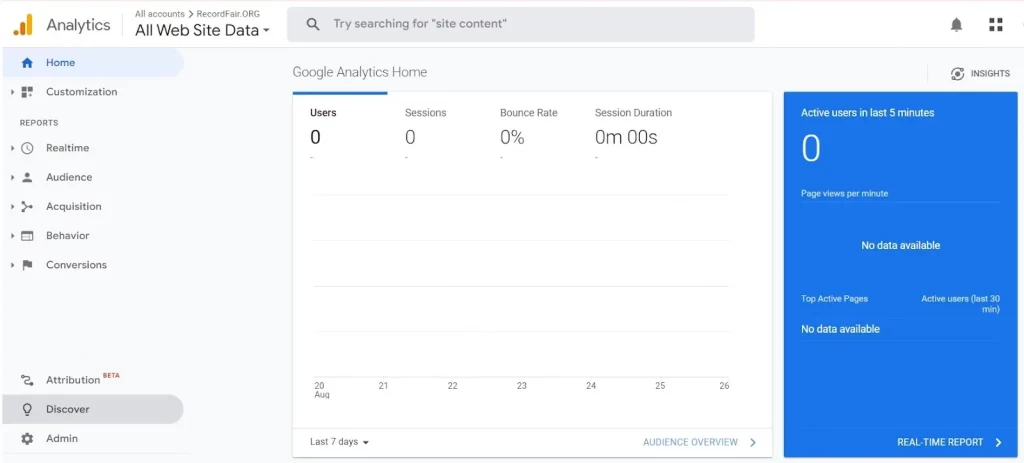
Google Analytics is a web analytics service provided by Google as part of their Marketing Platform. What makes it one of the best PR tools? It offers statistics and analytical tools to help you optimize your PR efforts, marketing strategies, and much more.
Pros of Google Analytics:
- Website Traffic Analysis: Google Analytics provides detailed insights into your website traffic. That includes the number of visitors, their geographic location, and the source of their traffic.
- Audience Analysis: Discover valuable information about your website visitors. That includes their demographics, behavior, and technology preferences.
- Conversion Tracking: Track and measure the performance of your PR campaigns and goals. For example, purchases, form submissions, or newsletter sign-ups.
- Customizable Reporting: Create customized reports to focus on the metrics that matter most to your PR efforts. Google Analytics allows you to schedule automated reports or access real-time data.
- Behavior Flow Analysis: Visualize the paths users take on your website. Understand how they navigate through different pages. This helps you optimize user experience and identify areas for improvement.
Cons of Google Analytics:
- Data Accuracy: There can be discrepancies in data accuracy due to factors like ad blockers, bot traffic, or incorrect implementation of tracking codes. It’s important to regularly monitor and validate data to ensure its accuracy.
- Steep Learning Curve: While Google Analytics offers a user-friendly interface, it can be overwhelming for beginners due to the vast amount of data and various metrics available. Understanding and interpreting the data may require some learning and training.
- Data Privacy Concerns: As with any analytics tool, there may be privacy concerns regarding the collection and processing of user data. It’s essential to comply with privacy regulations and ensure proper data handling practices.
- Limited Real-time Data: Google Analytics provides data with a slight delay, typically within a few hours, so it may not be suitable for real-time monitoring or immediate decision-making.
Pro Tip: If you’re doing any kind of digital marketing, you’re already using Google Analytics. To make it work as one of your PR tools, all you have to do is set up goals to track specific campaigns. Google Analytics can help you see if you’re getting referral, social, and organic traffic from different campaigns.
Want to know how your SEO and PR tools and strategies can merge for even better results for both? Check out our dedicated article: PR SEO – Synergy for Success [Tips, Tactics, and Best Practices]
5. MailChimp
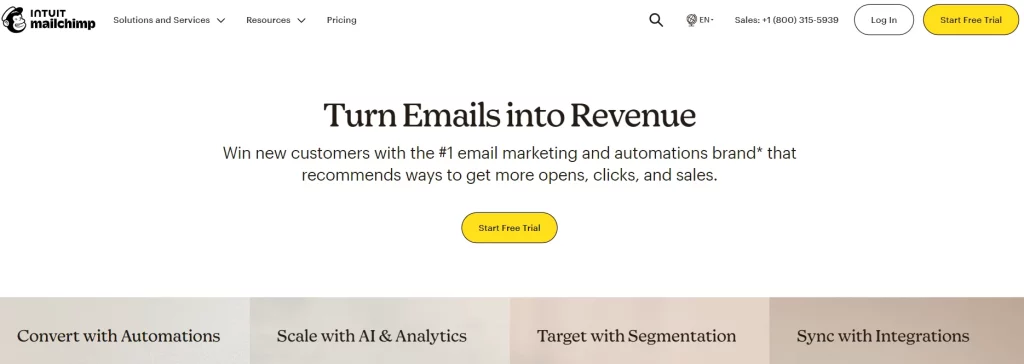
MailChimp is an email marketing platform that should be a part of your PR tools suite. That’s because this tool allows you to keep your audience informed and engaged. Plus, Mailchimp provides a user-friendly platform that doesn’t require advanced technical skills.
How should you use Mailchimp in your PR mix?
With its intuitive interface, you can effortlessly manage your PR outreach campaigns. Plus, you can create compelling email newsletters and track their performance.
Pros of Mailchimp:
- Email Automation: Mailchimp offers powerful automation features. This allows you to set up automated email campaigns based on triggers and customer actions.
- Advanced Segmentation: You can segment your email lists based on various criteria. This allows you to send more targeted campaigns to audience segments.
- A/B Testing: Mailchimp allows you to test different variations of your email campaigns. This helps you optimize your messaging and improve engagement.
- Robust Analytics: The platform provides detailed analytics and reports on email performance. This gives you insights into open rates, click-through rates, and more.
Cons of Mailchimp:
- Pricing Structure: As your email list grows, the cost of using Mailchimp can increase significantly. This makes it less affordable for small businesses with a large subscriber base.
- Limited Customer Support: Mailchimp’s customer support is primarily available through email and live chat. The response time may not always be immediate.
- Limited Design Flexibility: While Mailchimp offers a wide range of pre-designed templates, customization options can be somewhat limited.
- Limited CRM Capabilities: Mailchimp’s CRM features are not as robust as dedicated CRM platforms. If you rely heavily on customer relationship management, you may need to integrate with other software.
6. Google Alerts

Google Alerts is one of the best PR tools provided by Google. The tool is free and allows you to stay updated on specific topics of interest. You can receive email notifications whenever new information appears in Google Search and web content.
Pros of Google Alerts:
- Customizable Alerts: Users can create alerts for specific keywords, topics, or even their own brand name.
- Comprehensive Coverage: Google Alerts scours a vast range of sources for topic coverage. That includes news articles, blogs, websites, and even social media platforms.
- Real-time Updates: You can choose to receive alerts as they happen. This ensures that you stay on top of breaking news and time-sensitive information.
- Multiple Delivery Otions: You can use various delivery options to receive notifications. That includes email alerts or direct updates via RSS feeds.
- Advanced Search Operators: You can refine your alerts and narrow down the results. This allows for precise monitoring of specific phrases, domains, or geographic locations.
- Easy Management: Has a user-friendly interface for managing and organizing your alerts.
Cons of Google Alerts:
- Information Overload: Google Alerts is one of those PR tools that can flood your inbox with a barrage of notifications. Managing the influx of alerts can be overwhelming and time-consuming.
- Inaccurate or Irrelevant Results: Google Alerts may not always deliver the most accurate or relevant information. The algorithm might pick up unrelated or outdated content. This can lead to false positives or irrelevant alerts.
- Limited Customization Options: The customization is somewhat limited. You can choose the frequency, sources, and region. However, there are no advanced filters to refine the results based on specific criteria.
- Missed Opportunities: Google Alerts might not capture every relevant mention or update. The results are dependent on Google’s indexing. It may not cover all sources or update in real time.
7. Brandwatch
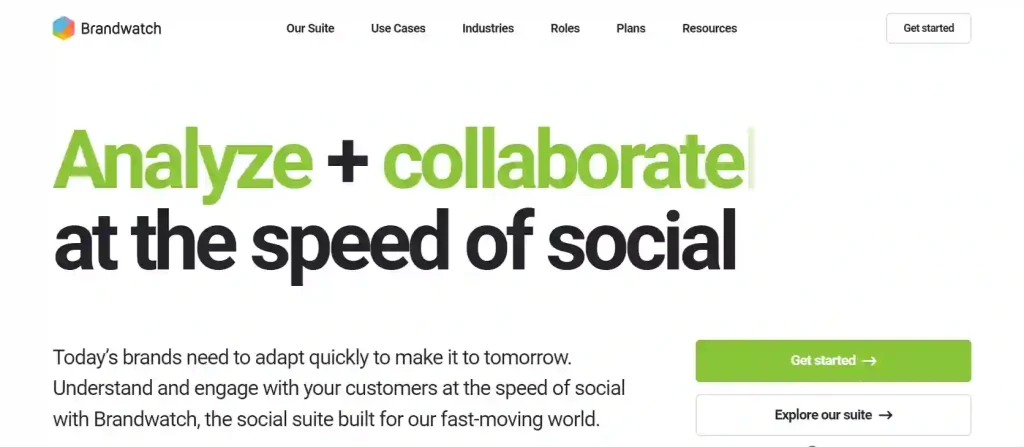
Brandwatch is another of our PR tools that isn’t strictly for PR. Brandwatch is a social media listening and analytics platform. It helps you gather and analyze data from various social media platforms. Additionally, it provides valuable insights into consumer trends, market research, and more.
Pros of Brandwatch:
- Social Media Monitoring: Monitor conversations happening on social media platforms in real time.
- Sentiment Analysis: This tool helps you understand the sentiment behind social media mentions.
- Trend Analysis: Keep track of trends and conversations around specific topics or hashtags.
- Influencer Identification: The platform helps you identify influencers in your industry or niche.
- Competitive Analysis: You can monitor your competitors’ social media activities and performance.
- Data Visualization: Brandwatch offers powerful data visualization tools, including customizable dashboards and reports. These visualizations make it easy to understand and present complex data.
- Crisis Management: Brandwatch provides real-time crisis monitoring and alerts. This allows you to respond quickly and effectively.
- API Access and Integrations: Brandwatch offers API access. This allows you to integrate its data and insights with other tools and platforms.
Cons of Brandwatch:
- Cost: Brandwatch comes with a significant price tag. The cost of subscription plans may be costly if you’re on a limited budget.
- Complexity: Brandwatch can be overwhelming for those without prior experience with social listening tools. The learning curve may require additional time and resources to fully grasp its capabilities.
- Data Limitations: Brandwatch may impose certain restrictions on the amount of data you can analyze. It may also restrict the number of social media profiles you can monitor.
- Steep Setup Process: Integrating Brandwatch with your existing systems can be a complex and time-consuming process.
Pro Tip: While not strictly falling under the umbrella PR tools, social media listening or management tools are important for PR. That’s because monitoring social media as a part of your PR campaign allows you to track things like reach, engagement, and sentiment. They also gives you time to respond in times of crisis.
Not sure how to understand and draw insights from PR data? Want to learn how to really get the most from your analytics? Read more here: 7 Step Guide to PR Analytics: Unveiling for Strategy Enhancement
8. Canva
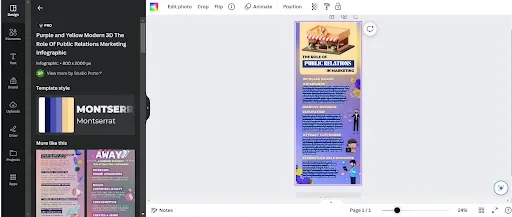
Need a a set of PR tools that can handle your digital design needs? Try Canva. With an easy-to-use platform, it allows you to work with photo editing, design layout, and more. That makes it one of the best PR tools for digital design.
Pros of Canva:
- Professional-looking Press Releases: Canva provides customizable and visually appealing press release templates.
- Eye-catching Media Kits: A media kit is an essential tool for PR. Canva makes it easy to create one. You can find pre-designed templates for media kits that allow you to showcase key information, media coverage, and more.
- Social Media Graphics: Canva offers a wide range of templates for social media graphics. That includes Instagram posts, Facebook covers, LinkedIn banners, and X (Twitter) headers.
- Infographics and Data Visualization: Canva’s infographic templates can be a game-changer for your PR campaign. You can easily create infographics to convey your messages, statistics, and industry insights.
Cons of Canva:
- Limited Customization: Canva provides many pre-designed templates and elements. This can be limiting for those seeking more unique or specific designs.
- Watermarked Content: The free version of Canva often includes a watermark on designs. This can only be removed by subscribing to a paid plan.
- Learning Curve: Although Canva is user-friendly, it still requires some learning and exploration. Users who are not design-oriented may find it time-consuming to familiarize themselves with it.
- Limited File Types: Canva focuses on web-based designs and offers limited options for downloading files in various formats. This can be a drawback if you need a specific file type. You might need to use other PR tools to convert your files to updated formats.
Now that you’ve gathered your data and made nice graphics, you need to put it all into a PR report. Have a look at our guide on PR reporting: PR Reporting – How to Use Data to Get Better Results [+3 Examples]
9. Help A Reporter (HARO)
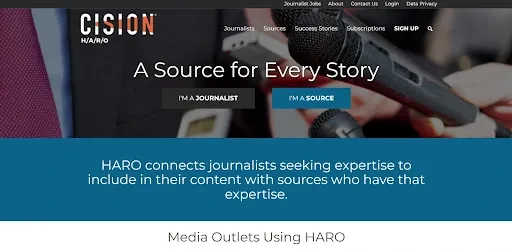
HARO is one of the best PR tools for quick and easy outreach and earned media wins. It’s an online service that enables journalists, bloggers, and website owners to connect with expert sources. It was founded in 2008 by Peter Shankman as a Facebook group. HARO later transformed into a mailing list.
Pros of HARO:
- Vast Networking: HARO boasts a vast network of journalists and reporters from various media outlets. This enables you to reach a wide audience.
- Source Queries: HARO sends out daily email alerts with source queries from journalists. This allows you to pitch your expertise directly to reporters.
- Credibility Building: HARO helps you build credibility and establish yourself as an authority in your field.
- Easy-to-use Platform: HARO’s platform allows you to create and manage your profile. Plus, you can respond to queries and track your media mentions.
- PR Opportunities: HARO opens opportunities for press coverage, media mentions, and brand exposure.
Cons of HARO:
- High Competition: HARO is used by thousands of reporters and sources. This means the competition to get a pitch noticed can be fierce.
- Time-consuming: Responding to queries requires time and effort to craft pitches that align with journalists’ needs. It can be time-consuming, especially if you’re not receiving many responses.
- Lack of Control: You have limited control over how your responses are used. Journalists may only use a small portion of your input. They may also edit it to fit their needs.
- Spam and Irrelevant Queries: HARO receives a vast number of queries. Not all of them may be relevant or legitimate.
- Limited Niche Opportunities: HARO may not always cater to highly specialized or niche industries. This could make it challenging to find relevant media opportunities.
Want to review a quick guide on PR writing before you get started with HARO pitching? Check it out: PR Writing – Crafting Convincing PR Content for Enhanced Results [+7 Examples]
10. ResponseSource

ResponseSource is one of the best all around PR tools on the list. In general, if you’re set on doing your own PR, having a tool like ResponseSource is a must.
It’s media intelligence platform that connects you with journalists, bloggers, and influencers. The tool comes a comprehensive media database and communication dashboard that helps you distribute press releases, pitches, and other media materials.
Pros of ResponseSource:
- Media Database: Access an extensive and up-to-date database of media contacts. You can find journalists, bloggers, and influencers.
- Press Release Distribution: Distribute your press releases efficiently and effectively. You can reach the right journalists and increase your chances of getting media coverage.
- Journalist Inquiry Service: Receive journalist inquiries in your inbox. These can be based on your specified industry or areas of expertise. You can also respond quickly and secure media opportunities.
- Media Monitoring: Stay informed about media coverage and industry trends with real-time monitoring. Receive alerts whenever your brand, competitors, or specific keywords are mentioned in the media.
- Campaign Management: Manage your PR campaigns effectively with ResponseSource’s campaign management tools. Track and analyze your media coverage, monitor journalist interactions, and measure the impact of your PR efforts.
- Influencer Outreach: Identify and connect with influential bloggers, social media personalities, and thought leaders through ResponseSource’s influencer database. Build relationships and collaborate with key influencers to amplify your brand’s reach.
- Media Contacts Database Integration: Seamlessly integrate ResponseSource’s media database with your existing CRM or PR software for enhanced efficiency and easy data management.
Cons of ResponseSource:
- Limited Coverage: ResponseSource primarily focuses on the UK media landscape. If your target audience or media outreach extends beyond the UK, it may not provide comprehensive coverage.
- High Competition: Due to its popularity, there can be intense competition for journalists’ attention. This means your pitches may get lost in the sea of other press releases and media requests.
- Limited Customization: ResponseSource offers various media categories and filters. But the level of customization may not meet every specific need or niche.
- Time-consuming: Keeping up with the constant influx of journalist requests and managing responses can be time-consuming. It requires consistent monitoring and prompt action to maximize the platform’s benefits.
Need to learn how to write a pitch? Not sure what’s going to work best with journalists? Learn more here: A Comprehensive Guide to Creating an Effective PR Pitch [Examples + Templates]
Key Takeaways on Using PR Tools
PR tools offer a range of features for your PR efforts. This includes press release distribution and media monitoring. You can use these tools to reach a wider audience, attract media attention, and improve your brand recognition.
PR tools also provide resources for building and maintaining relationships with stakeholders. You can easily identify relevant contacts and reach out to them with targeted pitches. Strengthening your media relationships can lead to increased media coverage and positive publicity.
Effective PR strategies require constant monitoring and evaluation. These tools offer analytics and reporting capabilities. This allows you to track the success of your campaigns and measure media mentions. These metrics can help you refine your strategies and make data-driven decisions.
Still not sure what mix of PR tools will be best for you? Let us help! Simply book a free consultation with us to get expert insight into which tools to choose for tracking and understand your PR results.

